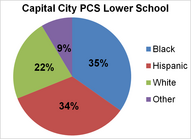DC’s most diverse charter schools

DC’s most diverse charter campus
Which DC charter schools are the most racially and ethnically diverse? Here’s a list.
To parents, the most important features of a school may include quality of instruction, proximity to home, and safety. These preferences matter in a place like DC where charter schools and choice are so prevalent. But many parents also look for another factor: racial and ethnic diversity.
The Public Charter School Board (PCSB) provided us with the numbers of students of different groups at each charter school campus. We then used those numbers to create a ranking of all DC charter school campuses from most to least diverse.
To measure “diversity” we divided the school populations into four categories: black, Hispanic, white, and “other,” with “other” including Asian, Native American, Pacific Islander, and multiracial. Then we ranked schools by the share of their largest group. The smaller the dominant group, the more diverse. (A breakdown of the “other” category is available here, along with a ranked list of all 103 campuses.)
By this definition, the most diverse campus in the city is Capital City’s lower school, where none of the four groups has more than 35% representation. All figures are for the 2012-13 school year, and school locations may not reflect moves to new buildings for the school year that just ended. (Capital City consolidated its upper and lower schools onto a new campus in Ward 4, but the new campus would also be the most diverse charter in the city by this measure).
Generally speaking, the diversity of these schools roughly reflects the ethnic make-up of the wards they’re in. Half of the top 10 schools are in Ward 1, which as of 2010 was 40% white, 33% black, and 21% Hispanic. Three of the others are in Ward 4, which is 59% black, 20% white, and 19% Hispanic. Two are in Ward 5, which is 77% black, 15% white, 6% Hispanic.
Most DC charter campuses are majority African-American. Five charters are majority Hispanic. The first eight of our top 10 have no group in the majority. On the other hand, you can form the groups differently, combining “other” with “white” or categorizing “multiracial” differently. Our spreadsheet shows these different calculations, but the rankings are mostly unaffected.
The overall picture in DC is that charter schools are disproportionately African-American. In a city that is just barely majority black, the percentage of black students in charter schools is 79%. In DCPS schools, the percentage is 69%.
Much of the explanation for this is location: Wards 7 and 8, which are about 95% black, have over 40 charter schools between them. On the other hand, Ward 3, which is about 80% white, has none.
The most diverse schools also tend to be towards the top of the heap in quality, according to the PCSB. Of the 10 schools listed, 6 are in Tier One, the highest grouping under the PCSB’s ranking system, the Performance Management Framework. One, Elsie Whitlow Stokes, is in Tier Two. Three aren’t ranked. One, Creative Minds, is too new to be ranked, and two others, Bridges and Mundo Verde, aren’t ranked because they’re categorized as early childhood campuses.
But parents who are eager to enroll their kids in one of these schools may have to get in line. As of June, all of them had wait lists of over 150. And in two cases (Capital City Lower School and Mundo Verde) those lists had well over 1,000 names on them.

